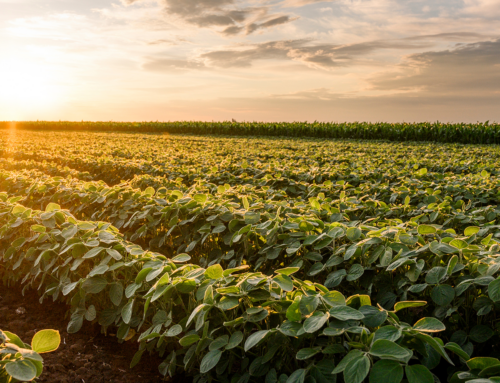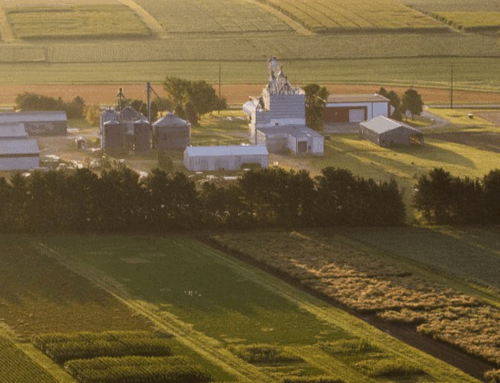
Changing times, improving yields: WSMB-funded research reaps rewards
Share This
Farming doesn’t look the same as it did 50 years ago.
Soybean growers plant straight rows with a tractor that drives itself instead of picking a point on the horizon and can receive yield information instantaneously from a monitor in their combine.
“Looking backwards 50 years, how things changed,” said retired farmer Kenlon Johannes, the first executive director of the Wisconsin Soybean Association (WSA). “I don’t know if I could start a tractor today.”
But the changes don’t stop with technology.
“Today, Wisconsin is the 13th largest soy producing state in the country, but it hasn’t always been,” Wisconsin Soybean Marketing Board (WSMB) President Patrick Mullooly said. “That’s no small thing. Since its inception, WSMB has worked with growers to increase their profitability by guiding them through the changes that come their way.”
Thanks to the continued wise investments of WSMB, Wisconsin’s 14,000 soybean farmers have seen increased profits over the last several decades, largely because of WSMB’s extensive research, education and promotion efforts.
We’ve come a long way from the early 1970s, when Wisconsin growers planted only around 200,000 acres of soybeans. Fifty years later, Wisconsin soybean growers planted 2.2 million acres and harvested 116 million bushels.
“Forty, fifty years ago, a big chunk of Wisconsin’s soybeans were planted as a forage crop in June,” said Shawn Conley, a soybean and small grain specialist at the University of Wisconsin-Madison. “Now, we’re asking farmers to plant it as a seed crop in April. The checkoff played a big role in that transition.”
Established in 1983 as part of the Wisconsin soy checkoff, WSMB predates the national soy checkoff program; the federal Soybean Promotion, Research and Consumer Information Act and Order was adopted in 1991 as part of the 1990 Farm Bill.
“Our ability to support Wisconsin-specific research with the checkoff has been a huge advantage,” said Nancy Kavazanjian, a longtime farmer-leader who represents Wisconsin on the United Soybean Board. “Before we had the state checkoff, we had to look at a lot at research coming out of other states.”
Today, WSMB reviews dozens of requests for proposals (RFPs), covering a wide range of project areas. The board reviews and chooses to fund projects that align with its strategic plan, which helps them map out its priorities for the year.
“Because the projects are funded by Wisconsin soybean farmer checkoffs, it makes sense that they’re reviewed by growers,” Mullooly said. “We know that what might help a grower in southern Wisconsin may not be all that important to a grower in northern Wisconsin. So, as a board, we meet in the middle to do what’s best for the majority of growers in the state.”
With a board comprising elected farmer leaders and overseen by the Wisconsin Department of Agriculture, Trade and Consumer Protection, WSMB supports research projects that address current and anticipated issues Wisconsin soy growers may face. Those projects help contribute to improved profitability: According to the latest United Soybean Board study, growers earn $12.34 in return value for every dollar invested into the checkoff.
“Not only is our research Wisconsin-specific, but it’s directed by farmers and not by industry,” Kavazanjian said. “Before the state checkoff, we did have a soybean research specialist, but we didn’t have the kind of funding we’re now able to give to the cause. And because of that, we mostly relied on industry to fund projects.”
Engagement opportunities
WSMB funded projects are not only selected by growers, but the proposed projects are also farmer-driven.
“We have a good relationship with not only the growers on the WSMB board, but growers across the state,” said Rodrigo Werle, extension cropping systems weed scientist at the University of Wisconsin, Madison. “Throughout the year, we have multiple opportunities to engage with soybean farmers. Along with presenting the research we’ve been working on, we discuss what their challenges are. It’s a two-way street.”
Strong relationships with industry partners are a vital component to WSMB’s success. By joining forces with respected researchers, checkoff investments go even further.
“I think the number one thing the checkoff has really done is allowed for us, as scientists, to develop foundational research that has driven soybean yield and profitability,” said Conley, who also serves on WSA’s board. “There isn’t a lot of federal funding for research, so the work that the checkoff has done to fund applied research has really helped us, as well as farmers, adapt to the changes in production systems over the years.”
WSMB’s reach goes beyond research. Developing new uses for soy and expanding export markets are two other key areas soybean checkoff dollars are invested.
“We have relied on our industry partners to develop our export markets to a large extent,” Kavazanjian said. “Right now, we’re looking at how we can work together to increase the use of the St. Lawrence Seaway, which would expand our export market potential.”
Building a network for soybean farmers to share their expertise has been another side effect of the soy checkoff.
“Peer knowledge has extended from across the fence line to across the country,” Conley said. “With the checkoff’s movement towards more of an open community, social media has allowed opportunities for farmers to connect in different ways. It’s allowed farmers to talk about what works on their farm in different parts of the country and others have been able to adapt some of those strategies.”
Not many things remain the same several years later. But WSMB’s dedication to put farmers in a positive light while increasing soybean profitability has and will remain constant for decades to come.
“In the next five to 10 years, I see great opportunities for growth in the state of Wisconsin,” Conley said. “It’s a super exciting time.”
Hundred high mark
In the early 1970s, soybean yields reached around 20-25 bushels per acre. In 2022, Wisconsin growers harvested beans averaging in the mid-50s.
“A lot of that has to do with the pairing of genetics and management and farmers really taking the time,” Conley said. “We’ve seen a huge improvement in the management of soybeans to help drive that interaction of genetics and yield forward.”
Thanks to growth research and technological advances like artificial intelligence and drones, Conley predicts 90-100 bushels per-acre is a realistic aspiration for Wisconsin growers within the next 10-15 years.
“We can take that data that’s hidden and take it to the farm level,” Conley said. “As we improve the soil profile by increasing sustainability and soil health and driving forward with genetics and management practices, 100 bushels is within reach. It’s coming closer and closer, and people are starting to believe.”



